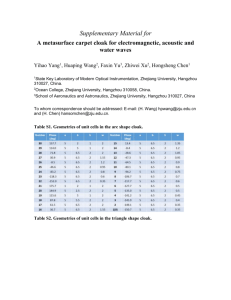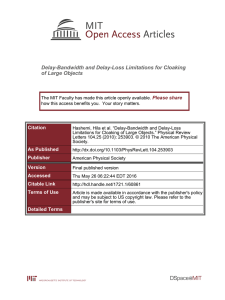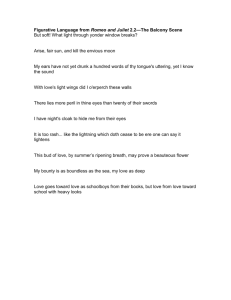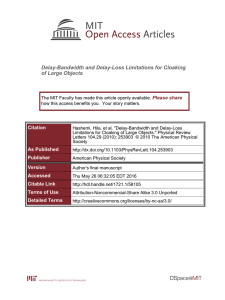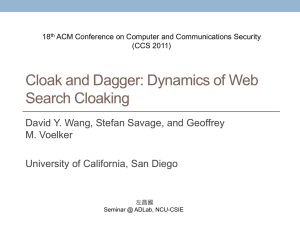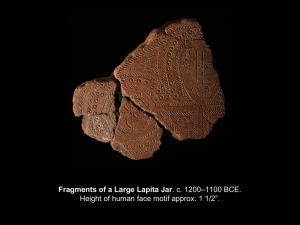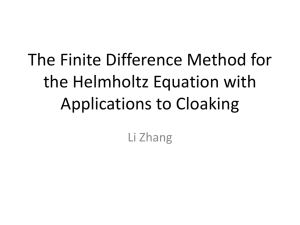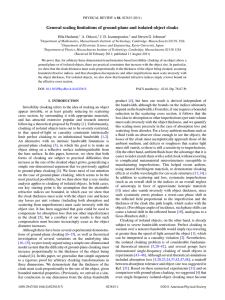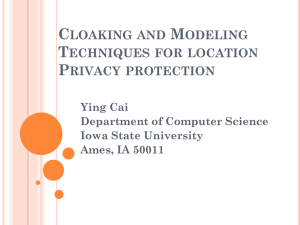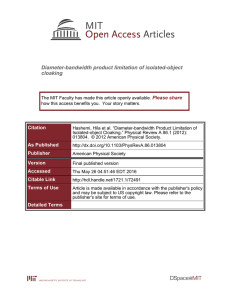Delay-Bandwidth and Delay-Loss Limitations for Cloaking of Large Objects Hila Hashemi,
advertisement
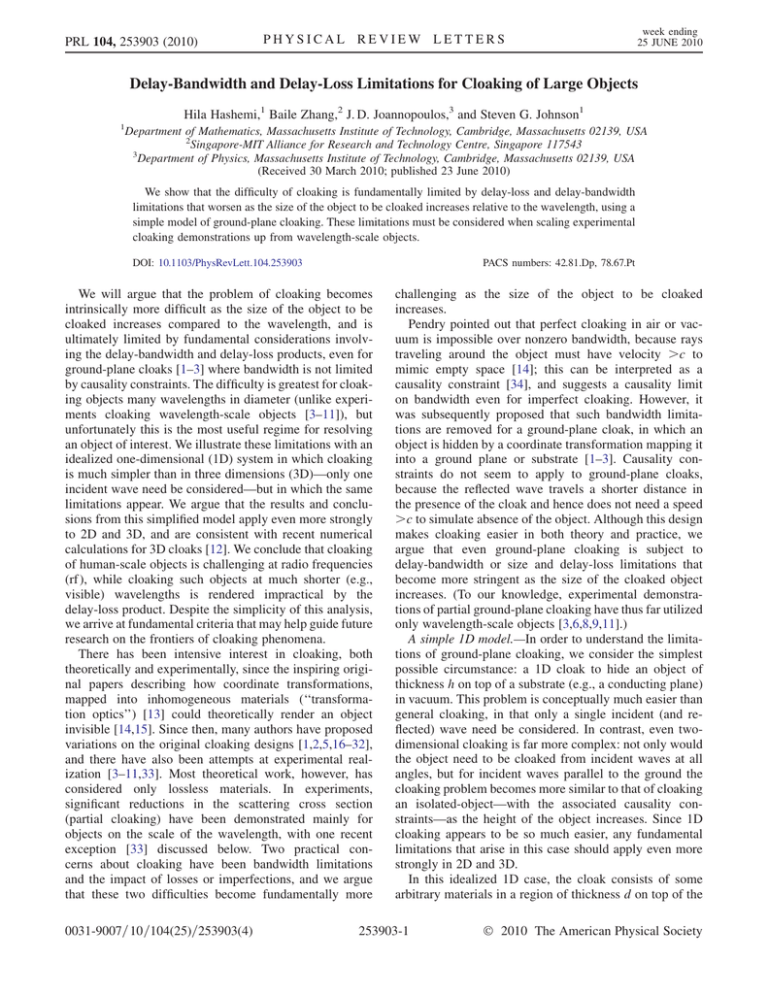
PRL 104, 253903 (2010) PHYSICAL REVIEW LETTERS week ending 25 JUNE 2010 Delay-Bandwidth and Delay-Loss Limitations for Cloaking of Large Objects Hila Hashemi,1 Baile Zhang,2 J. D. Joannopoulos,3 and Steven G. Johnson1 1 Department of Mathematics, Massachusetts Institute of Technology, Cambridge, Massachusetts 02139, USA 2 Singapore-MIT Alliance for Research and Technology Centre, Singapore 117543 3 Department of Physics, Massachusetts Institute of Technology, Cambridge, Massachusetts 02139, USA (Received 30 March 2010; published 23 June 2010) We show that the difficulty of cloaking is fundamentally limited by delay-loss and delay-bandwidth limitations that worsen as the size of the object to be cloaked increases relative to the wavelength, using a simple model of ground-plane cloaking. These limitations must be considered when scaling experimental cloaking demonstrations up from wavelength-scale objects. DOI: 10.1103/PhysRevLett.104.253903 PACS numbers: 42.81.Dp, 78.67.Pt We will argue that the problem of cloaking becomes intrinsically more difficult as the size of the object to be cloaked increases compared to the wavelength, and is ultimately limited by fundamental considerations involving the delay-bandwidth and delay-loss products, even for ground-plane cloaks [1–3] where bandwidth is not limited by causality constraints. The difficulty is greatest for cloaking objects many wavelengths in diameter (unlike experiments cloaking wavelength-scale objects [3–11]), but unfortunately this is the most useful regime for resolving an object of interest. We illustrate these limitations with an idealized one-dimensional (1D) system in which cloaking is much simpler than in three dimensions (3D)—only one incident wave need be considered—but in which the same limitations appear. We argue that the results and conclusions from this simplified model apply even more strongly to 2D and 3D, and are consistent with recent numerical calculations for 3D cloaks [12]. We conclude that cloaking of human-scale objects is challenging at radio frequencies (rf), while cloaking such objects at much shorter (e.g., visible) wavelengths is rendered impractical by the delay-loss product. Despite the simplicity of this analysis, we arrive at fundamental criteria that may help guide future research on the frontiers of cloaking phenomena. There has been intensive interest in cloaking, both theoretically and experimentally, since the inspiring original papers describing how coordinate transformations, mapped into inhomogeneous materials (‘‘transformation optics’’) [13] could theoretically render an object invisible [14,15]. Since then, many authors have proposed variations on the original cloaking designs [1,2,5,16–32], and there have also been attempts at experimental realization [3–11,33]. Most theoretical work, however, has considered only lossless materials. In experiments, significant reductions in the scattering cross section (partial cloaking) have been demonstrated mainly for objects on the scale of the wavelength, with one recent exception [33] discussed below. Two practical concerns about cloaking have been bandwidth limitations and the impact of losses or imperfections, and we argue that these two difficulties become fundamentally more 0031-9007=10=104(25)=253903(4) challenging as the size of the object to be cloaked increases. Pendry pointed out that perfect cloaking in air or vacuum is impossible over nonzero bandwidth, because rays traveling around the object must have velocity >c to mimic empty space [14]; this can be interpreted as a causality constraint [34], and suggests a causality limit on bandwidth even for imperfect cloaking. However, it was subsequently proposed that such bandwidth limitations are removed for a ground-plane cloak, in which an object is hidden by a coordinate transformation mapping it into a ground plane or substrate [1–3]. Causality constraints do not seem to apply to ground-plane cloaks, because the reflected wave travels a shorter distance in the presence of the cloak and hence does not need a speed >c to simulate absence of the object. Although this design makes cloaking easier in both theory and practice, we argue that even ground-plane cloaking is subject to delay-bandwidth or size and delay-loss limitations that become more stringent as the size of the cloaked object increases. (To our knowledge, experimental demonstrations of partial ground-plane cloaking have thus far utilized only wavelength-scale objects [3,6,8,9,11].) A simple 1D model.—In order to understand the limitations of ground-plane cloaking, we consider the simplest possible circumstance: a 1D cloak to hide an object of thickness h on top of a substrate (e.g., a conducting plane) in vacuum. This problem is conceptually much easier than general cloaking, in that only a single incident (and reflected) wave need be considered. In contrast, even twodimensional cloaking is far more complex: not only would the object need to be cloaked from incident waves at all angles, but for incident waves parallel to the ground the cloaking problem becomes more similar to that of cloaking an isolated-object—with the associated causality constraints—as the height of the object increases. Since 1D cloaking appears to be so much easier, any fundamental limitations that arise in this case should apply even more strongly in 2D and 3D. In this idealized 1D case, the cloak consists of some arbitrary materials in a region of thickness d on top of the 253903-1 Ó 2010 The American Physical Society PRL 104, 253903 (2010) week ending 25 JUNE 2010 PHYSICAL REVIEW LETTERS object, as depicted in Fig. 1. We assume that the ground plane reflects light with negligible loss in the bandwidth of interest (in the trivial case of a black ground plane, one would merely need a black cloak). The function of the cloak is now simple: the cloak must reflect incident waves with a delay equal to the time (and phase) delay 0 2ðh þ dÞ=c that the reflected wave would incur in the absence of the cloaked object. A similar delay must also be achieved in 2D or 3D cloaking for beams at any angle— the cloak must simulate the delay from bouncing ‘‘through’’ the object off the ground plane, and in fact the required delay increases for more oblique incidence (longer paths through the object). To be more precise, suppose that the reflected wave from the bare ground plane, at a height h þ d, has a phase ð!Þ ð!0 Þ þ 0 ð!0 Þ ð! !0 Þ near some frequency !0 , where the derivative 0 ð!0 Þ ¼ 0 is the time delay [35]. There are two cases. First, the phase-delay case: if the bandwidth is narrow, so that 0 ð!0 Þð! !0 Þ can be neglected, then the cloak merely need achieve the correct phase ð!0 Þ, but this imposes a bandwidth constraint: the delay-bandwidth product 0 ! must be small. (This corresponds to incident pulses of duration 1=! 0 .) Second, the time-delay case: if the delay-bandwidth product is not small, then 0 ð!0 Þð! !0 Þ cannot be neglected and the cloak must achieve a true time delay 0 (an !-dependent phase). This raises two additional difficulties. First, it is well known that the achievable delay-bandwidth product in finite-size passive linear systems is limited [35–37]. Second, a long dwell time in the cloak means that loss in the cloak must be small. We deal with each of these requirements below. Delay-bandwidth limitation.—The achievable time delay 0 in a passive linear system (unlike time-varying active devices [38]) is limited: for a given bandwidth ! and diameter d of the delay region, the maximum delay is proportional to d=!. The scaling of delay with bandwidth is known as the delay-bandwidth product limitation [35], and in the case of a single resonant filter the upper bound on 0 ! is of order unity as a consequence of the Fourier uncertainty relation [35,39]. To obtain a bandwidth much larger than 1=0 , one can chain multiple filters into a slow-light delay line, or even forgo slow light and use source cloak object reflective ground plane FIG. 1 (color online). A 1D ground-plane cloak. propagation through a long region—in any case, the maximum delay is proportional to the diameter of the region. A more careful analysis for slow-light delay lines yields a delay-bandwidth limit of 0 !=! & ðn 1Þ2d=c, where n is the effective index in the delay region [36], and a more optimistic bound of nðn 1Þ2d=c was derived under more general assumptions [37]. As a consequence of this and 0 > 2h=c, the cloak thickness d must grow proportional to h: d* h ! : nðn 1Þ ! (1) [This is probably optimistic in the wide-bandwidth regime where slow light is difficult to utilize; for a nonslow cloak of thickness d, where the time delay is simply 2dn=c and must be >2ðh þ dÞ=c, one obtains a minimum thickness d > h=ðn 1Þ.] One can relax this tradeoff if a larger n can be obtained, but large indices of refraction (arising from resonances) are associated with narrow bandwidths and/or large losses [40]. Delay-loss limitation.—In the time-delay regime, a larger object for a given bandwidth means that the incident wave needs to spend more time in the cloak, which will tend to increase losses due to absorption and imperfections. The loss per time is proportional to ! Imn=Ren for light confined mostly in a given index n [41]. To maintain effective invisibility, the loss incurred in the cloak must be small: one must have 0 1 for negligible absorption. But, since 0 > 2ðh þ dÞ=c, this implies the following limitation on the loss tangent: 1 Imn : 4 h þ d Ren (2) That is, less and less loss can be tolerated for larger objects relative to the vacuum wavelength . In the phase-delay regime, the dwell time inside the cloak can be independent of h, in which case the loss tolerance does not decrease as h= increases, at the expense of greatly reduced bandwidth. Interface reflections.—A low-loss cloak achieving the requisite time delay is useless if there is substantial reflection off the surface of the cloak itself. In 1D, eliminating reflections reduces to the problem of impedance matching the cloak with vacuum [42]. In the transformation-optics approach, impedance matching is attained automatically: the 1D transformation results in a cloak material that has both a permittivity " and a permeability (for polarizations transverse to the surface normal), such that the impffiffiffiffiffiffiffiffiffiffi pedance =" exactly equals that of vacuum [13]. Alternatively, if the material is varying slowly enough, this can be approximately commuted with the curls in Maxwell’s equations to combine it with " into an index pffiffiffiffiffiffiffiffiffiffiffiffiffiffiffiffiffiffiffiffi n ¼ "="0 0 . This is equivalent to an antireflective (AR) coating formed by a slowly varying n (in the ‘‘adiabatic’’ limit of slow variation the reflection vanishes [43]). 253903-2 week ending 25 JUNE 2010 PHYSICAL REVIEW LETTERS This means that a homogeneous medium cannot be used for the cloak. To obtain a , metamaterials employing subwavelength metallic resonances are typically used [4,44], whereas a continuously varying n is typically achieved with a microporous structure whose porosity is gradually varied [8,9,11,45]. In either case, the loss limit in the previous section must then include fabrication disorder and surface roughness in addition to absorption. Examples and results.—Let us take some real-world examples of cloaking applications and study what practical limitations one would face even for an idealized 1d ground-plane cloak. For microwave frequencies, consider cloaking a vehicle of height 2 m from a radar of wavelength 1:25 cm (24 GHz). Using a time-delay cloak of thickness 10 cm over a 10% bandwidth, Eqs. (1) and (2) imply an effective index of *1:4 and a loss tangent of 4:7 104 . (Operating in the phase-delay regime would imply a fractional bandwidth of <104 .) [Although one might expect a cloak of thickness h=20 to need n ¼ 20 for the requisite delay, Eq. (1) assumes that slow light or resonances are used to exploit the narrow !]. To time-delay cloak the same object at visible frequencies with a 10 cm cloak, aiming for 10% bandwidth around 575 nm, we would again need n * 1:4, but with a loss tangent 2 108 . (In the phase-delay regime, the bandwidth would be only 0.013 pm.) Although such low losses may seem attainable, e.g., with oxides, even in 1D a microstructured medium is required for impedancematching as described above, and in 2D and 3D even more complicated metamaterials seem necessary [2,3,8,9,11,45] (anisotropy requirements can be minimized via quasiconformal transformations [2], although discarding anisotropy incurs a lateral shift in reflected beams [46]). For a cloak at 10 GHz, an experimental absorption loss tangent 103 was obtained [4] for a wavelengthscale object; this is already too lossy for 1D cloaking a meter-scale object, from above. A ground-plane cloak can use nonresonant microstructures that may be lower loss [2,3], but for an object that stands many wavelengths above the ground, the problem of cloaking against oblique waves seems to approach isolated-object cloaking. Nevertheless, we cannot say that the loss bounds from the 1D cloaking problem are definitely unattainable for cloaking meterscale objects at microwave frequencies, although it appears challenging. On the other hand, loss tangents 108 seem impossibly small for any metamaterial with metallic constituents at infrared or visible frequencies. Even if groundplane cloaking permits the use of purely dielectric constituents, such a loss tangent appears almost unattainable when scattering from fabrication disorder and nonzero gradients (nonadiabaticity) is included, since the requisite gradients (especially for cloaks not too much bigger than the cloaked object) seem to imply constituent materials with large index contrasts (oxide and air or larger) [8,9,11]. For comparison, a waveguide with a loss tangent of 109 at 1 m wavelength would correspond to decay lengths of 1 km—orders of magnitude better than the cm-scale decay lengths typically achieved at infrared frequencies in geometries (such as strip waveguides) with wavelengthscale geometric components, and a metamaterial requires components much smaller than the wavelength (thus many more surfaces). Visible-wavelength cloaking, therefore, seems restricted to cloaking objects that are many orders of magnitude smaller than meter scales. These calculations demonstrate the difficulty of cloaking objects much larger than the wavelength when the ambient medium is air or vacuum. The problem may become easier if the ambient medium itself is lossy, such as for an object immersed in water or inside a lossy waveguide. In that case, the loss of the cloak need only be comparable to that of the surrounding medium. The delay-bandwidth constraint remains, however: the cloak thickness must grow proportional to that of the object being cloaked, for a fixed bandwidth. However, if the velocity of light in the ambient medium is <c, the causality constraint on wide-bandwidth cloaking of isolated objects [14,34] is lifted. A possible example can be found in Ref. [33], which cloaked an ‘‘object’’ (a place where two surfaces touched) roughly 100 wavelengths in diameter (this ‘‘diameter’’ was indirectly measured and may not be comparable to the diameters of objects used in other cloaking problems), but did so in a waveguide between two metallic surfaces. Such a waveguide has a group velocity <c, eliminating the causality constraint, and may also have non-negligible absorption loss. In addition, the cloaking region in Ref. [33] was achieved by curving the surfaces smoothly, which allows a smooth variation of the effective index without microstructured media—it seems plausible that such a cloak has at least 100 times lower absorption or scattering loss than was present in metamaterial cloaks. 100 delay-loss high absorption regime (predicted) loss tangent Im n/Re n PRL 104, 253903 (2010) 10-2 clo ak los s th d cloak -4 res ho ld (co mp 10 ute d) h Object 10-6 100 101 102 (h+d)/λ 10 3 104 FIG. 2 (color online). Maximum cloak loss tangent versus diameter h for cloaking a perfectly conducting sphere, for cloak of thickness d ¼ h=12. Shaded area is the regime of high absorption predicted by the simple 1D model of Eq. (2). The red curve, data from Ref. [12], shows the maximum loss tangent to obtain 99% reduction in the scattering cross section using a Pendry-type cloak. 253903-3 PRL 104, 253903 (2010) PHYSICAL REVIEW LETTERS Although we presented the basic delay-loss and delaybandwidth or size tradeoffs in the context of an idealized 1D cloaking problem, we believe that similar tradeoffs must apply even more strongly to the more difficult problem of cloaking objects in 2D and 3D, especially without a ground plane. In fact, recent numerical experiments have shown that similar tradeoffs (loss tolerance scaling inversely with diameter) arise for three-dimensional cloaking of a perfectly conducting sphere of diameter h [12]. In Fig. 2, we show the loss threshold vs h for this 3D cloak when the (single-!) reduction in the scattering cross section is fixed to 1=100, for cloak thickness d ¼ h=12. The scattering is calculated with a transfer-matrix method in a spherical-wave basis [12,30]. Not only does the maximum loss scale exactly inversely with the diameter, but the constant factor in this relationship is consistent with the requirement Eq. (2) that the loss be much smaller than =2ðh þ dÞ (shaded region) derived from the much simpler 1D model (using a path length h instead of 2h since there is no ground plane to double the optical path). This work was supported in part by the Army Research Office through the Institute for Soldier Nanotechnologies (ISN) under Contract No. W911NF-07-D-0004. We are grateful to the referees for helpful comments. [1] P. Zhang, Y. Jin, and S. He, Opt. Express 16, 3161 (2008). [2] J. Li and J. B. Pendry, Phys. Rev. Lett. 101, 203901 (2008). [3] R. Liu, C. Ji, J. J. Mock, J. Y. Chin, T. J. Cui, and D. R. Smith, Science 323, 366 (2009). [4] D. Schurig, J. J. Mock, B. J. Justice, S. A. Cummer, J. B. Pendry, A. F. Starr, and D. R. Smith, Science 314, 977 (2006). [5] B. Kanté, A. de Lustrac, J.-M. Lourtioz, and S. N. Burokur, Opt. Express 16, 9191 (2008). [6] H. F. Ma, W. X. Jiang, X. M. Yang, X. Y. Zhou, and T. J. Cui, Opt. Express 17, 19 947 (2009). [7] X. Liu, C. Li, K. Yao, X. Meng, W. Feng, B. Wu, and F. Li, Appl. Phys. Lett. 95, 191107 (2009). [8] L. H. Gabrielli, J. Cardenas, C. B. Poitras, and M. Lipson, Nat. Photon. 3, 461 (2009). [9] J. Valentine, J. Li, T. Zentgraf, G. Bartal, and X. Zhang, Nature Mater. 8, 568 (2009). [10] I. I. Smolyaninov, Y. J. Hung, and C. C. Davis, Opt. Lett. 33, 1342 (2008). [11] T. Ergin, N. Stenger, P. Brenner, J. B. Pendry, and M. Wegener, Science (to be published). [12] B. L. Zhang, H. S. Chen, and B.-I. Wu, Prog. Electromagn. Res. 97, 407 (2009). [13] A. J. Ward and J. B. Pendry, J. Mod. Opt. 43, 773 (1996). [14] J. B. Pendry, D. Schurig, and D. R. Smith, Science 312, 1780 (2006). [15] U. Leonhardt, Science 312, 1777 (2006). [16] D. Schurig, J. B. Pendry, and D. R. Smith, Opt. Express 14, 9794 (2006). week ending 25 JUNE 2010 [17] S. A. Cummer, B.-I. Popa, D. Schurig, D. R. Smith, and J. Pendry, Phys. Rev. E 74, 036621 (2006). [18] H. Chen, B.-I. Wu, B. Zhang, and J. A. Kong, Phys. Rev. Lett. 99, 063903 (2007). [19] Y. Huang, Y. Feng, and T. Jiang, Opt. Express 15, 11 133 (2007). [20] F. Zolla, S. Guenneau, A. Nicolet, and J. B. Pendry, Opt. Lett. 32, 1069 (2007). [21] W. Cai, U. K. Chettiar, A. V. Kildishev, and V. M. Shalaev, Nat. Photon. 1, 224 (2007). [22] H. Chen, Z. Liang, P. Yao, X. Jiang, H. Ma, and C. T. Chan, Phys. Rev. B 76, 241104(R) (2007). [23] M. Yan, Z. Ruan, and M. Qiu, Phys. Rev. Lett. 99, 233901 (2007). [24] M. Rahm, D. Shurig, D. A. Roberts, S. A. Cummer, D. R. Smith, and J. B. Pendry, Photonics and Nanostructures: Fundamentals and Applications 6, 87 (2008). [25] D.-H. Kwon and D. H. Werner, Appl. Phys. Lett. 92, 013505 (2008). [26] W. X. Jiang, T. J. Cui, G. X. Yu, X. Q. Lin, and Q. Cheng, J. Phys. D 41, 085504 (2008). [27] H. Ma, Appl. Phys. Lett. 94, 103501 (2009). [28] B.-I. Popa and S. A. Cummer, Phys. Rev. A 79, 023806 (2009). [29] W. Cai, U. K. Chettiar, A. V. Kildishev, V. M. Shalaev, and G. W. Milton, Appl. Phys. Lett. 91, 111105 (2007). [30] C. Qiu, L. Hu, B. Zhang, B.-I. Wu, S. G. Johnson, and J. D. Joannopoulos, Opt. Express 17, 13 467 (2009). [31] E. Kallos, C. Argyropoulos, and Y. Hao, Phys. Rev. A 79, 063825 (2009). [32] U. Leonhardt and T. Tyc, Science 323, 110 (2009). [33] I. I. Smolyaninov, V. N. Smolyaninova, A. V. Kildishev, and V. M. Shalaev, Phys. Rev. Lett. 102, 213901 (2009). [34] D. A. B. Miller, Opt. Express 14, 12 457 (2006). [35] G. Lenz, B. J. Eggleton, C. K. Madsen, and R. E. Slusher, IEEE J. Quantum Electron. 37, 525 (2001). [36] R. S. Tucker, P. C. Ku, and C. J. Chang-Hasnain, Electron. Lett. 41, 208 (2005). [37] D. A. B. Miller, Phys. Rev. Lett. 99, 203903 (2007). [38] M. F. Yanik and S. Fan, Stud. Appl. Math. 115, 233 (2005). [39] M. A. Pinsky, Introduction To Fourier Analysis And Wavelets (Brooks/Cole, Pacific Grove, CA, 2002). [40] J. D. Jackson, Classical Electrodynamics (Wiley, New York, 1998), 3rd ed.. [41] J. D. Joannopoulos, S. G. Johnson, J. N. Winn, and R. D. Meade, Photonic Crystals: Molding The Flow Of Light (Princeton University Press, Princeton, New Jersey, 2008), 2nd ed.. [42] J. A. Stratton, Electromagnetic Theory (McGraw-Hill, New York, 1941). [43] S. G. Johnson, P. Bienstman, M. A. Skorobogatiy, M. Ibanescu, E. Lidorikis, and J. D. Joannopoulos, Phys. Rev. E 66, 066608 (2002). [44] J. B. Pendry, A. J. Holden, D. J. Robbins, and W. J. Stewart, IEEE Trans. Microwave Theory Tech. 47, 2075 (1999). [45] M.-L. Kuo, D. J. Poxson, Y. S. Kim, F. W. Mont, J. K. Kim, E. F. Schubert, and S.-Y. Lin, Opt. Lett. 33, 2527 (2008). [46] B. Zhang, T. Chan, and B.-I. Wu, arXiv:1004.2551. 253903-4
